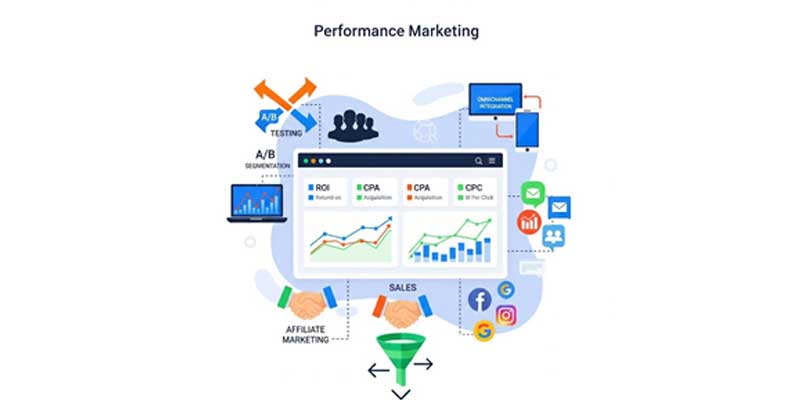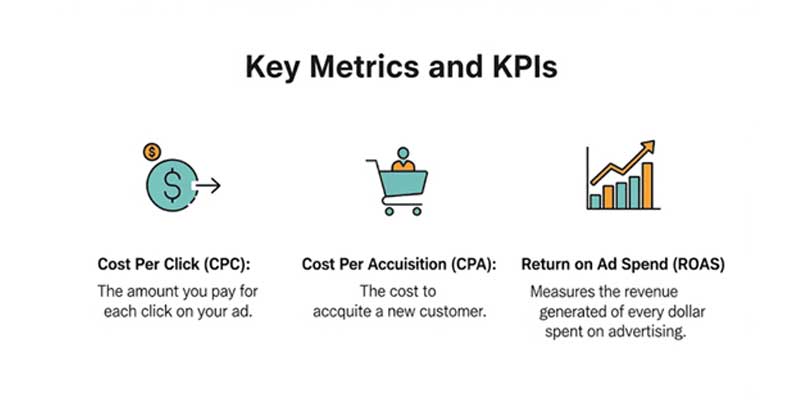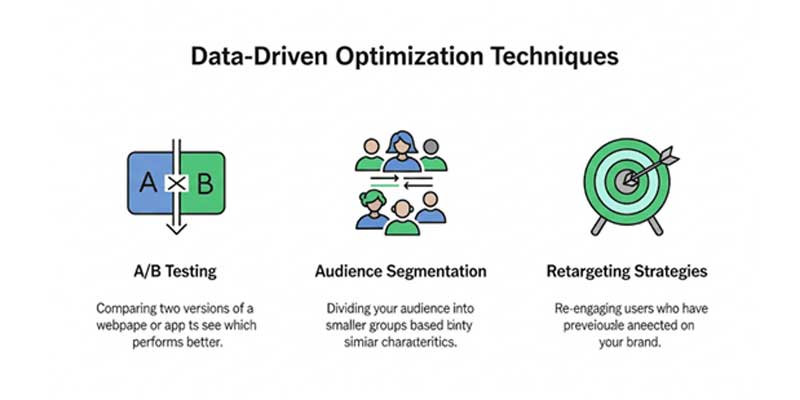

Marketing is an essential aspect of any business. Good marketing translates to higher profits and better business. Therefore, resources need to be channeled in extra effort needs to be made when it comes to marketing.
Over the years in India, almost every digital marketing agency has invested a decent amount in various marketing strategies and creative ideas, to elevate the profits of companies. However, performance marketing is one of those rare strategies, which is both affordable and effective and guarantees success.
Considering the return on investment and profits acquired through this method, there is a huge benefit with performance marketing in India.
Performance marketing is a results-driven digital marketing approach where advertisers pay only when a specific action or outcome is achieved. Unlike traditional marketing, where spending is often based on impressions or exposure, performance marketing focuses on measurable outcomes such as clicks, leads, sales, or conversions. This method ensures that every marketing dollar is directly tied to tangible results, making campaigns more accountable and efficient.
At its core, performance marketing combines data analysis, technology, and strategy to track user behavior and optimize campaigns for maximum return on investment (ROI). By leveraging tracking tools and analytics platforms, businesses can measure key performance indicators (KPIs) such as Cost Per Click (CPC), Cost Per Acquisition (CPA), and Return on Ad Spend (ROAS). These metrics not only provide insights into campaign effectiveness but also guide marketers in refining their strategies for better performance.
Performance marketing has gained significant traction in the digital era because it aligns marketing efforts with business objectives. Advertisers can experiment with different channels, creative content, and targeting strategies while monitoring results in real time. This adaptability ensures that resources are allocated to high-performing campaigns, reducing waste and improving overall marketing efficiency. In essence, performance marketing transforms marketing from a cost center into a measurable driver of business growth.
Performance marketing fundamentally differs from traditional advertising in both approach and accountability. Traditional advertising often relies on broad-based campaigns where payment is made upfront for exposure through channels like TV, radio, or print media. Success in these campaigns is measured through reach, impressions, or brand awareness, making it difficult to directly link spending to business outcomes.
In contrast, performance marketing operates on a pay-for-performance model. Advertisers pay only when a specific, measurable action is completed—whether it’s a click, a form submission, a sale, or another conversion event. This creates a direct correlation between marketing investment and tangible results, allowing businesses to track ROI with precision.
Another key distinction lies in optimization. Traditional campaigns are typically planned for longer durations with limited flexibility for real-time adjustments. Performance marketing, however, leverages advanced tracking and analytics to continuously monitor campaign effectiveness and make data-driven adjustments. Channels such as search engine marketing (SEM), social media advertising, affiliate marketing, and influencer collaborations provide marketers with granular insights into what works and what doesn’t.
Moreover, performance marketing emphasizes accountability and efficiency. Marketers can allocate budgets to the most effective channels, test multiple strategies simultaneously, and scale successful campaigns quickly. Unlike traditional advertising, which often requires guesswork and estimated outcomes, performance marketing ensures that every marketing action has a measurable impact on business growth.
Performance marketing relies on precise measurement and strategic execution to ensure campaigns deliver measurable results. Understanding the core components of performance marketing allows businesses to track effectiveness, optimize spend, and maximize return on investment. Among these core elements, key metrics and attribution models play a crucial role in evaluating success and shaping future strategies.
At the heart of performance marketing are the metrics and KPIs that define success. These indicators provide actionable insights into how campaigns perform and where improvements can be made. Some of the most critical metrics include:

Monitoring these metrics consistently ensures that campaigns are data-driven, measurable, and focused on achieving concrete outcomes. Furthermore, businesses can experiment with different ad creatives and targeting strategies to enhance these KPIs. For example, learning how to craft compelling ad creatives can boost engagement and reduce CPC. Read more: 5 ENGAGING FACEBOOK AD CREATIVES TIPS.
Attribution models play a pivotal role in understanding the customer journey and assigning credit to various marketing touchpoints. Selecting the right attribution model allows businesses to identify which channels, campaigns, and interactions drive conversions. Common models include:
By leveraging these models, businesses can gain actionable insights into the effectiveness of their campaigns, optimize channel strategies, and maximize ROI. Combined with key metrics, attribution modeling ensures that performance marketing efforts remain both accountable and impactful.
Performance marketing leverages multiple digital channels and strategies to achieve measurable results. Selecting the right mix of channels ensures campaigns reach the target audience effectively while maximizing ROI. Understanding the role of each channel and strategy is critical for optimizing performance marketing campaigns.
Search Engine Marketing (SEM) is a cornerstone of performance marketing. It involves paid advertising on search engines like Google and Bing to target users actively searching for relevant products or services. SEM allows marketers to bid on specific keywords, ensuring ads appear in search results when potential customers are most likely to convert.
The advantage of SEM lies in its intent-based targeting: ads reach users who already demonstrate interest in a product or service. By optimizing ad copy, selecting high-performing keywords, and continuously monitoring campaign performance, businesses can achieve lower Cost Per Click (CPC) and higher conversion rates. SEM campaigns also benefit from advanced analytics tools, enabling real-time adjustments that improve ROI over time.
When combined with strategies like search engine marketing (SEO), businesses can create a holistic approach that drives both immediate visibility through paid ads and long-term organic growth. This dual strategy ensures sustainable results, positioning brands strongly in competitive digital landscapes.
Social media platforms like Facebook, Instagram, LinkedIn, and Twitter play a pivotal role in performance marketing. These platforms allow highly targeted campaigns based on demographics, interests, behavior, and even past interactions with a brand.
Paid social campaigns drive engagement, clicks, and conversions while offering precise tracking of performance metrics. The interactive nature of social media also enables businesses to test different creatives, messaging, and formats to see what resonates best with their audience. Additionally, platforms like Facebook provide advanced retargeting options that help marketers re-engage users who have previously interacted with their content.
When executed strategically, social media marketing becomes a powerful driver of performance-based results, ensuring brands build visibility, strengthen customer relationships, and achieve measurable ROI across multiple platforms.
Affiliate and influencer marketing are performance-based partnerships where payment is tied to specific outcomes, such as sales or leads. Affiliates promote products through blogs, websites, or email campaigns, earning a commission for each successful conversion. Influencers, on the other hand, leverage their social media following to drive awareness and engagement, often focusing on niche audiences.
These partnerships are effective because they combine credibility with targeted reach. Affiliates and influencers act as trusted sources, increasing the likelihood of conversions while minimizing upfront advertising costs. By tracking clicks, conversions, and sales, marketers can identify the most effective partners and scale campaigns accordingly.
Native advertising integrates promotional content seamlessly within the user experience, making ads appear as part of the platform’s content. This approach reduces ad fatigue and increases engagement because users are more likely to interact with content that feels natural and relevant.
Examples include sponsored articles, in-feed social media ads, or recommended content on platforms like Outbrain and Taboola. Native advertising not only drives clicks and conversions but also enhances brand awareness by presenting messages in a contextually relevant way. When combined with performance marketing tracking tools, businesses can measure engagement, conversion rates, and ROI with precision.
For marketers looking to improve digital content and campaigns, implementing effective copywriting strategies is essential. Read more: TOP 20 SEO COPYWRITING TIPS.
Measuring and optimizing campaigns is a critical step in performance marketing. Unlike traditional marketing, which often focuses on exposure or impressions, performance marketing relies on real-time data to evaluate effectiveness and make informed decisions. By leveraging the right tools and techniques, businesses can identify top-performing campaigns, optimize underperforming ones, and ensure maximum ROI.
Effective performance marketing requires the use of advanced tools and platforms that allow marketers to manage, monitor, and analyze campaigns efficiently. Some of the most widely used platforms include:
These tools streamline campaign management and provide the necessary data to make strategic decisions. Marketers can track KPIs, monitor ad performance, and adjust campaigns in real time to improve efficiency and outcomes.
Optimizing campaigns in performance marketing involves using data to make informed, iterative improvements. Key strategies include:

By combining advanced tools with data-driven optimization techniques, performance marketing campaigns can be refined for maximum impact. This approach ensures that resources are spent efficiently, ROI is measurable, and marketing efforts contribute directly to business growth.
The digital marketing landscape is evolving rapidly, and performance marketing is no exception. Staying ahead of emerging trends is essential for businesses that want to maximize ROI and maintain a competitive edge. In 2025, three key trends—AI and automation, privacy regulations, and omnichannel strategies—are shaping how performance marketing campaigns are designed, executed, and measured.
Artificial intelligence (AI) and automation are transforming performance marketing by enabling marketers to analyze large datasets, predict user behavior, and optimize campaigns in real time. AI-driven tools can automatically adjust bids, allocate budgets, and personalize ad creatives for different audience segments.
Automation also allows marketers to streamline repetitive tasks such as reporting, campaign scheduling, and retargeting, freeing up time for strategic decision-making. For instance, machine learning algorithms can identify patterns in user behavior and suggest the most effective targeting strategies, ensuring campaigns deliver higher engagement and conversion rates.
The integration of AI and automation not only increases efficiency but also enhances personalization, enabling brands to deliver highly relevant content to users at the right time. This shift from manual management to intelligent, data-driven optimization is redefining success in performance marketing.
With increased data collection comes greater responsibility. Privacy regulations such as the General Data Protection Regulation (GDPR) and the California Consumer Privacy Act (CCPA) have significantly impacted how marketers collect, store, and use consumer data. Compliance with these laws is crucial to avoid penalties and maintain trust with users.
Performance marketing campaigns must prioritize data ethics, ensuring transparency in how data is gathered and used. Strategies such as anonymized tracking, explicit user consent, and secure data storage are becoming standard practice. Marketers also need to adapt to changes in cookie policies and third-party data restrictions by leveraging first-party data and consent-driven analytics to maintain campaign effectiveness.
By balancing personalization with privacy, businesses can continue to deliver targeted campaigns while respecting consumer rights—a necessity for sustainable growth in 2025.
Omnichannel marketing is the practice of providing a seamless and consistent user experience across multiple platforms, including search engines, social media, email, mobile apps, and offline channels. In performance marketing, omnichannel integration ensures that messaging aligns across all touchpoints, creating a cohesive customer journey that drives conversions.
For example, a user who clicks on a paid search ad might later receive retargeted social media ads and follow-up emails that reinforce the original message. This coordinated approach not only improves engagement but also strengthens brand recall and trust. Analytics across channels help marketers understand how each touchpoint contributes to conversions, enabling better budget allocation and campaign optimization.
By integrating omnichannel strategies, performance marketers can create a unified experience that enhances both user satisfaction and business results, positioning brands for long-term success in a competitive digital landscape.
Understanding performance marketing in theory is important, but analyzing real-world examples provides actionable insights for marketers. Case studies from leading brands demonstrate how effective strategies, data-driven optimization, and innovative approaches can lead to measurable business growth.
Several global brands have leveraged performance marketing to achieve remarkable results. For example:
These examples illustrate the importance of aligning performance marketing strategies with business objectives, leveraging data insights, and maintaining flexibility to adapt campaigns based on measurable outcomes.
From these case studies, several key lessons and best practices emerge:
By applying these lessons, businesses can refine their performance marketing strategies, avoid common pitfalls, and maximize the impact of their campaigns.
While performance marketing offers measurable results and high ROI, businesses often face several challenges in planning and executing campaigns. Understanding these obstacles and implementing effective strategies to overcome them is crucial for sustained success.
One of the most common challenges in performance marketing is determining how to allocate budgets and resources effectively across multiple channels. A well-planned distribution ensures that campaigns achieve maximum impact without overspending.
To overcome this challenge, marketers should:
Effective budget management ensures that marketing efforts are aligned with business goals and maximizes returns from every marketing dollar spent.
Digital advertising platforms frequently update their algorithms and policies, which can disrupt performance marketing campaigns if marketers are unprepared. These changes may impact ad delivery, targeting options, or campaign reach, potentially affecting ROI.
To navigate these challenges, marketers should:
By proactively adapting to changes and implementing robust monitoring strategies, businesses can minimize disruptions and continue to achieve consistent results from their performance marketing efforts.
Performance marketing continues to evolve at a rapid pace, driven by technological advancements and changing consumer behaviors. Businesses that anticipate these shifts and adopt innovative practices will gain a competitive edge in the years ahead.
Emerging technologies are set to redefine the landscape of performance marketing. 5G connectivity will enhance real-time interactions, enabling faster-loading ads, immersive video experiences, and seamless mobile shopping journeys. This heightened speed and reliability allow marketers to deliver richer, more engaging campaigns without compromising user experience.
Augmented Reality (AR) is also poised to play a crucial role. Brands can create interactive ad experiences that let consumers virtually try products before purchasing, significantly boosting engagement and reducing hesitation in the buying journey. For instance, AR-enabled ads in fashion or home décor can drive higher conversions by bridging the gap between online browsing and physical experiences.
Blockchain technology is set to revolutionize data transparency and trust in advertising. With its decentralized nature, blockchain can validate ad impressions, prevent ad fraud, and ensure accurate attribution. This level of accountability will give brands and consumers more confidence in digital campaigns, ultimately improving ROI.
Alongside technological advancements, consumer behavior is undergoing profound changes. Today’s consumers demand personalization, authenticity, and seamless digital experiences. They expect brands to understand their preferences and deliver relevant offers at the right time. This has made data-driven strategies and AI-powered targeting more critical than ever.
Moreover, modern consumers are highly aware of privacy issues. They value transparency and are more selective about the data they share. As a result, marketers must strike a balance between personalization and ethical data usage, adopting strategies that respect consumer trust while delivering tailored experiences.
Additionally, the rise of omnichannel engagement reflects how consumers interact with brands across multiple touchpoints—from social media and mobile apps to physical stores. Businesses must ensure consistent messaging and cohesive journeys, meeting consumers wherever they are in their decision-making process.
Looking ahead, successful performance marketing will hinge on the ability to embrace these behavioral shifts while leveraging emerging technologies to create campaigns that are not only measurable but also meaningful to audiences.
Performance marketing empowers businesses to drive measurable results, optimize spending, and scale campaigns with precision. By leveraging channels like SEM, social media, affiliates, and native advertising—alongside clear KPIs and attribution models—brands can build strategies that balance immediate impact with long-term growth.
With a focused roadmap and adaptive approach, businesses can harness performance marketing to achieve consistent ROI and future-ready growth.